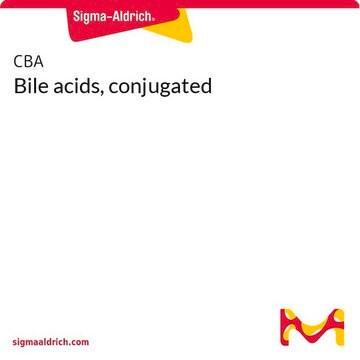ML0015
Aspartate Metabolite Library
Sinônimo(s):
Aspartic acid Metabolite Library
Faça loginpara ver os preços organizacionais e de contrato
About This Item
Código UNSPSC:
12352209
NACRES:
NA.25
Produtos recomendados
descrição
Aspartate pathway
Nível de qualidade
forma
solid
aplicação(ões)
metabolomics
temperatura de armazenamento
−20°C
Descrição geral
Aspartic acid (or aspartate) is a non-essential amino acid, which means that it is naturally synthesized by mammals. Aspartate presents many biochemical roles:
In the L-conformation, aspartic acid is a building block in the production of proteins, as well as aiding in many bodily functions, including the urea cycle, gluconeogenesis, and Krebs Cycle, a process that generates adenosine triphosphate (ATP). Aspartic acid also works as a neurotransmitter. The D-Aspartate conformation is linked to neurogenesis and endocrine systems.
In the L-conformation, aspartic acid is a building block in the production of proteins, as well as aiding in many bodily functions, including the urea cycle, gluconeogenesis, and Krebs Cycle, a process that generates adenosine triphosphate (ATP). Aspartic acid also works as a neurotransmitter. The D-Aspartate conformation is linked to neurogenesis and endocrine systems.
Aplicação
The Aspartate Metabolite Library is a kit that contains a selection of 23 metabolite involved in Aspartate metabolism.These may be used for general research, as reagents or as reference compounds in analytical procedures.
Ações bioquímicas/fisiológicas
Aspartate roles and metabolites:
- Aspartate is synthesized by transamination of oxaloacetate through the actions of Aspartate aminotransferase and pyridoxal 5′- phosphate. Aspartyl-tRNA synthase can then couple the aspartate to aspartyl tRNA for protein synthesis.
- Aspartate carries the reducing equivalents in the mitochondrial Malate-Aspartate shuttle, which uses the ready interconversion of aspartate and oxaloacetate.
- N-acetylaspartate synthase, present in the cytoplasm, converts aspartate to N-acetylaspartate, a brain metabolite that regulates dopamine.
- Asparagine is biosynthesized by Asparagine synthetase from aspartate, glutamine, and ATP. Asparagine is involved in the metabolic control of cell functions in nerve and brain tissue.
- Arginosuccinic acid is synthesized from aspartate, citrulline and ATP through the action of Argininosuccinate synthase, one of the enzymes of the urea cycle. In this metabolic pathway, neurotoxic ammonia, produced by protein catabolism, is converted into urea in the liver.
- Fumaric acid is synthesized from Argininosuccinic acid via an Argininosuccinate lyase, which is an enzyme in the Citric Acid Cycle.
- Inosinic acid, aspartic acid and GTP are interconverted to GDP and AMP by the Adenylosuccinate synthetase isozyme 1. This process is involved in the purine nucleotide cycle which regulates nucleotides levels in various tissues.
- Aspartate transcarbamoylase catalyzes the synthesis of N-carbamoyl-L-aspartate from carbamoyl phosphate and aspartate that are involved in the de novo biosynthesis of pyrimidines.
- Beta alanine is formed by decarboxylation of aspartate by Glutamate decarboxylase 1 in the cytoplasm.
- L-aspartate is converted to D-aspartate through the action of a D-aspartate racemase. D-aspartate contributes to the synthesis and release of glucocorticoids, prolactin, oxytocin, and steroids. D-aspartate plays an important role in the brain activity of mammals.
Componentes
Contains 10 mg each of Aspartate metabolism metabolite standards packaged individually.
Componentes do kit também disponíveis separadamente
Nº do produto
Descrição
SDS
- A2252Adenosine 5′-monophosphate monohydrate, from yeast, ≥97%SDS
- A2383Adenosine 5′-triphosphate disodium salt hydrate, Grade I, ≥99%, from microbialSDS
- A5707Argininosuccinic acid disodium salt hydrate, ≥80%SDS
- 146064β-Alanine, 99%SDS
- C4135Carbamyl phosphate disodium salt, ≥80%SDS
- C7629L-Citrulline, ≥98% (TLC)SDS
- 219096D-Aspartic acid, ReagentPlus®, 99%SDS
- F6625Flavin adenine dinucleotide disodium salt hydrate, ≥95% (HPLC), powderSDS
- 47910Fumaric acid, ≥99.0% (T)SDS
- G7252Guanosine 5′-diphosphate tris salt from Saccharomyces cerevisiae, Type VI, ≥92.5%SDS
- G9002Guanosine 5′-triphosphate tris salt, ≥93% (HPLC), powderSDS
- I2879Inosine 5′-monophosphate from Saccharomyces cerevisiae, ≥98%SDS
- A5006L-Arginine, reagent grade, ≥98%SDS
- A0884L-Asparagine, ≥98% (HPLC)SDS
- 11189L-Aspartic acid, BioUltra, ≥99.5% (T)SDS
- G1251L-Glutamic acid, ReagentPlus®, ≥99% (HPLC)SDS
- G3126L-Glutamine, ReagentPlus®, ≥99% (HPLC)SDS
- 00920N-Acetyl-L-aspartic acid, ≥99.0% (T)SDS
- O4126Oxaloacetic acid, ≥97% (HPLC)SDS
- K1750α-Ketoglutaric acid, ≥98.5% (NaOH, titration)SDS
- P9255Pyridoxal 5′-phosphate hydrate, ≥98%SDS
- P8010Sodium pyrophosphate tetrabasic, ≥95%SDS
- 69037Ureidosuccinic acid, 98.0-102.0% (T)SDS
Ver tudo (23)
produto relacionado
Palavra indicadora
Danger
Frases de perigo
Declarações de precaução
Classificações de perigo
Acute Tox. 4 Oral - Eye Dam. 1
Código de classe de armazenamento
11 - Combustible Solids
Certificados de análise (COA)
Busque Certificados de análise (COA) digitando o Número do Lote do produto. Os números de lote e remessa podem ser encontrados no rótulo de um produto após a palavra “Lot” ou “Batch”.
Já possui este produto?
Encontre a documentação dos produtos que você adquiriu recentemente na biblioteca de documentos.
Pyrimidine Biosynthesis
Lennarz W J, et al.
Encyclopedia of Biological Chemistry, 600-605 (2004)
Kıvanç Birsoy et al.
Cell, 162(3), 540-551 (2015-08-02)
The mitochondrial electron transport chain (ETC) enables many metabolic processes, but why its inhibition suppresses cell proliferation is unclear. It is also not well understood why pyruvate supplementation allows cells lacking ETC function to proliferate. We used a CRISPR-based genetic
Ifeanyi J Arinze
Biochemistry and molecular biology education : a bimonthly publication of the International Union of Biochemistry and Molecular Biology, 33(3), 165-168 (2005-05-01)
Some metabolic processes are readily understood because they are circumscribed in metabolic pathways that have clearly identifiable beginning points, end products, and other features. Other metabolic pathways that do not appear to be straightforward pose difficulties for students. One such
F Errico et al.
Translational psychiatry, 4, e417-e417 (2014-07-30)
D-aspartate (D-Asp) is an atypical amino acid, which is especially abundant in the developing mammalian brain, and can bind to and activate N-methyl-D-Aspartate receptors (NMDARs). In line with its pharmacological features, we find that mice chronically treated with D-Asp show
Antimo D'Aniello et al.
Neuroscience letters, 651, 151-158 (2017-05-11)
Depressive symptoms and other neuropsychiatric dysfunctions are common in neurodegenerative disorders, including chronic pain and dementia. A correlation between the β-amyloid protein accumulation and the development of depression has been suggested, however the underlying mechanisms are unknown. d-Aspartate (d-Asp) is
Nossa equipe de cientistas tem experiência em todas as áreas de pesquisa, incluindo Life Sciences, ciência de materiais, síntese química, cromatografia, química analítica e muitas outras.
Entre em contato com a assistência técnica









